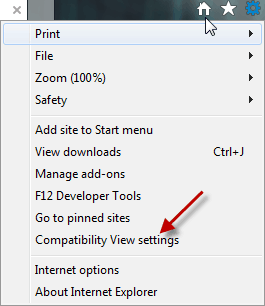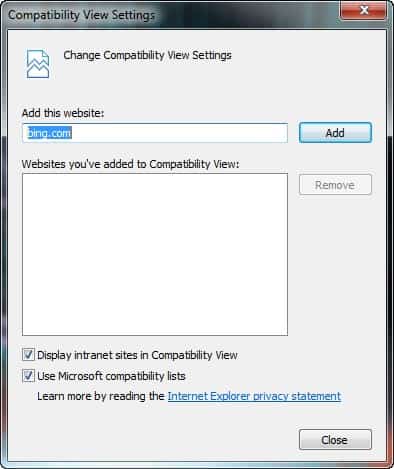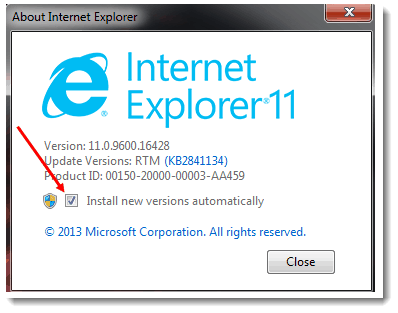How to Uninstall Ie 10 From Windows 7 64 Bit
Given the rapid progression of Internet Explorer upgrades, from IE 8 through IE 11, not every website and cloud based service has kept pace. I continue to get calls from family, students, and clients trying to view web pages or run applications that fail in IE 11.
Microsoft makes it very easy to add a website to compatibility view. Select the Option Gear.

Then select Compatibility View Settings

And add the URL for the website to your Compatibility view list.

If you have a mission critical application that is not supported by IE 11, you might have to try another browser, or downgrade to an earlier version of IE. Easier said than done, at least in the latter case.
One client could not manage to get a legacy accounting application to work, no matter what we tried. I guess bankers are just slow to change? So we decided to remove Internet Explorer 11, and return to IE 10, through which the legacy application worked as documented. Envisioning potential problems, I did some homework and testing. My discoveries follow.
Microsoft suggests that you cannot uninstall Internet Explorer 11, though you can turn it off per the following article. You merely go to Control Panel, Programs, Turn Windows Features on or off, and de-select the Internet Explorer 11 check box. Install or uninstall Internet Explorer
That works, but you are suddenly left without a browser. Or any means to acquire one unless you planned ahead and installed Chrome, Mozilla Firefox, Safari or an alternative in advance. As long as you consider an alternate browser for compatibility, there is no need to turn off or remove IE 11. Most co-exist nicely. So you reverse the process and re-enable IE 11.
Although Microsoft says you 'cannot' uninstall IE 11, there are a number of vendors who have identified how to downgrade back to IE 10.
Before you start, make certain to download a valid copy of IE 10 from Microsoft first.
And because it is not as simple as even I will attempt to make the process, grab the appropriate copy of the IE 11 installer in the process. The 32 bit and 64 bit versions are not at the same URL. Make sure you have the one that matches your system. (But you want to remove IE 11, why would you download the installer…there is a good reason, which I shall shortly explain.)
Internet Explorer 11 for Windows 7 (32 bit)
Internet Explorer 11 for Windows 7 (64 bit)
Make a note regarding your download save location. You might even want to check to assure that the entire download completes. The IE 10 install executable is about 40 MB. While IE 11 requires 30 to50 MB depending in the version.
A few words of caution. Some of the instructions, including the site I am about to reference below, suggest acquiring IE 10 (or earlier versions) from alternate download sites. We tried one just for effect, and received a copy of IE 10 laced with toolbars, pop-ups, and alternate vendor content. All annoying even if harmless. Always stick with the original source.
The best step by step instructions for removing IE 11 can be found at: How to Uninstall Internet Explorer 11 for Windows 7
This site nicely displays the sequence of simple steps, though does not caution you about potential pitfalls.
IE 11 was installed as a software update, so you will be uninstalling the update by viewing Installed Updates through the Control Panel. As suggested in the step-by-step instructions, you will need to find and remove all IE updates. Yes ALL, IE 11 updates. Removing just the line listing the IE 11 Update will not remove IE 11 and will potential create a larger issue.
Wait just a minute, though… two steps before you begin the IE 11 removal process.
Make sure that the Windows Update process runs. Even if you do not have any new updates, you might need Windows Update for recovery if the removal process runs astray. (Mine did once, and I was glad I had alternatives – I just repeated the update process.
Before you get started, you want to prevent Internet Explorer 11 from reinstalling itself via the auto-update feature.
Select the Internet Explorer tools icon (the gear), and then select about Internet Explorer …
![]()
and then select About Internet Explorer. Deselect the "Install new versions automatically" check box, and then accept the prompt allowing Internet Explorer 11 to make changes to your computer.

You are now ready to uninstall Internet Explorer 11.
Shut down IE 11. And to be safe, launch the Task Manager and make sure that all IE processes complete and terminate. IElowutil.exe is a potentially overlooked example. It can take five minutes or more for IE processes to complete.
Be patient.
You don't want any residue. You might even consider restarting your system, as long as you do not have IE set to launch upon startup.
Head for the Control Panel. Find and remove ALL Internet Explorer Updates.
And herein lies your potential challenge. You may need to search to find them all. hey do not all identify 'Internet Explorer' in their listed identities.
If you miss one, and then attempt to re-install IE 10, you will receive a pop-up message indicating that the install could not complete since there is a newer version of Internet Explorer on your system. Control Panel, Windows Features, and even the launch shortcut all reference IE 10. Though it will not launch. Ouch! You will need to re-install IE 11 and begin all over again. Hence my suggestion that you have a copy of the appropriate IE 11 installer available.
Wait a few minutes after you have all the updates removed, then check your Task Manager again to make sure that there are no IE processes and that all Windows Update (removal) processes have completed.
Now restart your computer.
Double check you Start menu and Desktop to confirm that IE 11 is truly removed. You might even check Control Panel > Windows Features to assure the feature is missing.
(Though I only recommend this for the experienced, I checked the registry to see what kind of residue remains.)
Navigate to the location for the IE 10 download and run the installer. Since you are probably using Windows 7, make sure you right (alt) click the executable and run it as an administrator.
If you properly removed all the IE 11 related updates, IE 10 works as expected. And the compatibility problem was resolved.
Patience was key. I had to try to effort several times before all of the IE 11 residue was removed and I could successfully install IE 10.
Maybe another browser is a better idea? Now you have more choices.
Best of luck!
How to Uninstall Ie 10 From Windows 7 64 Bit
Source: https://www.interfacett.com/blogs/how-to-replace-internet-explorer-version-11-with-ie-10/